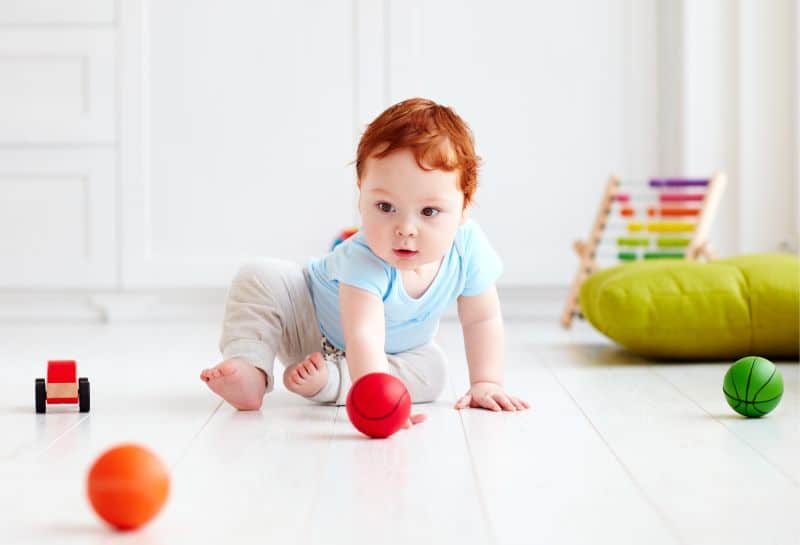Being a new mom can be overwhelming, especially when you pour over all the baby books and they all start referring to the heaps of milestones your little one should be doing at any given time of their tiny little life. By the age of 5 months they should be able to tie their own shoes and talk in full coherent sentences, right?
All jokes aside, what the books don’t always cover are playgrounds for babies and busy toddlers. To top it off, play areas, play structures, and playground equipment aren’t always in the budget, time, or space of busy family life.
So here are a few ideas that’ll help to reach those milestones, grow those baby brains, and make your busy toddler sleep… like a baby at night.
The most important thing any playground needs to have is not expensive play sets or an elaborate indoor playground facility.
It just has to be fun.
All of us learn at a different pace, but I think we can all agree that we learn much quicker if it’s fun.
It’s fun to play on a swing set and get those neurons firing while gaining motor skills on the climbing wall.
But what if your town’s playground only consists of a park or caters to older kids? Where do you go to have playtime with your little crawler?
The answer lies in your imagination and your ability to make almost anything fun. Don’t let those “what to expect” books overwhelm you anymore.
Make your home or backyard the best playground for babies and toddlers.
The biggest draw card any play area has is the fact that it’s outdoors.
From any baby or toddler’s perspective, anywhere is outdoors for them and almost anything could be turned into a toy. (You already know this if you’ve tried to pry the TV remote or keys from your toddler’s hands!)
The best part of a DIY play space at home is that you don’t need to leave your house to give your child stimulating playground activities.
You also don’t need to lug the stroller, diaper bag or all other 20-or-so items needed for diaper change to the nearest public restroom.
DIY Playground Activities For Babies And Young Children
Babies (3-8 months)
For your baby, all you need is your living room floor, bed, or even the sofa.
From here you can do almost anything to encourage movement, brain stimulation, and most of all, fun. Babies at this age learn with touch.
It’s almost as if their entire mouth is filled with taste buds. They explore everything in what we ended up calling “the test center” – their mouth.
Almost everything goes there. Blocks, dollies, teething rings and even the dogs tail.
Fun games for your little one will most likely happen during tummy time, which helps them to develop a strong neck and good sense of their world.
Place your baby tummy-down on the bed or living room floor and surround their immediate space with brightly colored toys and stuffed animals.
They will try to turn their head to each side to see everything around them. It’s important to talk to your little one during this, as it will help them to develop their language skills too.
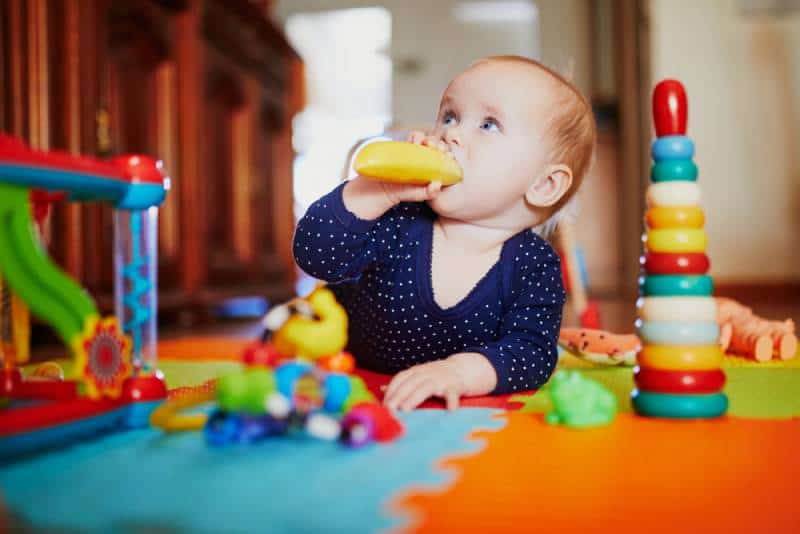
Now for the fun part. Go on a safari using only animal toys, while making the sounds and movements of those animals.
You can even turn your back yard into a mini water park with sea animal toys while blowing bubbles.
Watch them try and follow the bubbles, all while giving them running commentary. Even let them feel the soap.
Remember to give them time to respond. They’re learning something new and their brains need to catch up too.
Babies have a short attention span, so don’t make it over-complicated or your efforts will go to waste. You know your little one by now, so when it starts to get too much, take a break.
The best baby activities are multi-dimensional so try to engage as many of the senses as you can: sight, smell, and most importantly touch.
They are very tactile from a young age, so explore textures. The great thing is everything you’re using comes from your own home or kitchen, so you know where it’s been!
Little Crawlers (9-12 months)
Your little crawler might be making you rethink your entire home at this point.
From your coffee table book collection to cupboards that suddenly need to be baby-locked. Everything knee high is up for grabs.
This exploration phase is fascinating and the speed with which they process information is shocking.
And as for keeping them busy, that’s all up to how far you stretch your imagination (just don’t forget knee pads to keep your baby’s skin safe and protected).
The tupper cupboard is the best place to have them, if you want to get to housework while keeping a watchful eye on them.
Let them unpack (probably throw out) everything they can reach. Show them how lids fit on top of the different bowl shapes and how to take it off again.
Sort the colors together or count each piece as it flies across the floor.
Roll a ball and ask them to go get it. If they can sit, play bowling with soft balls, stacking blocks or any soft toys.
They will aim bad and throw miss, but cheer them on anyway. Kids learn by example.
They respond to encouragement and cheering, so cheer the miss or the fact that the dog caught the ball instead.
Encourage them to try again until they get it right, but don’t force it. If they give up, let them try another time. They’ll learn at their own pace.
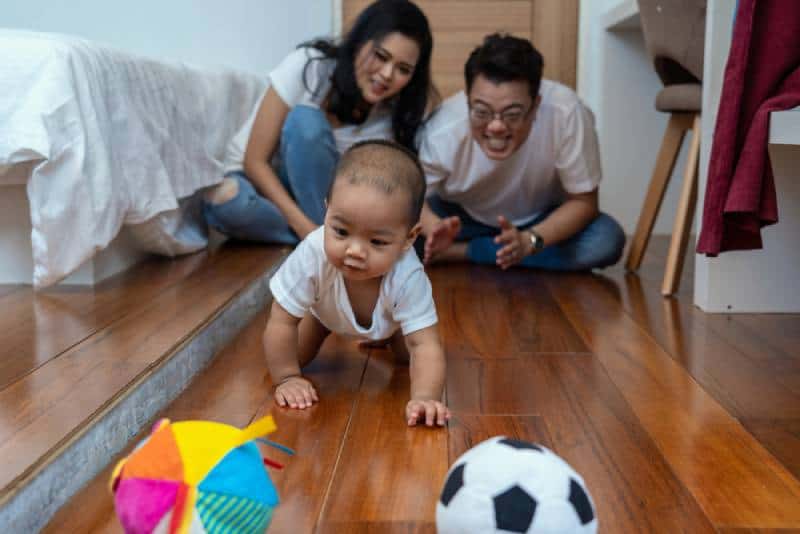
Place rice or seeds in a plastic container, crank up the music and make music together.
Dance to different beats (the sillier the better) and teach them various beats and tempos, wave your hands in the air, or clap to the beat, then watch them try to mimic you.
You can even place pots and pans on the floor and let them bang away with a wooden spoon. Just make sure they don’t hit themselves in the process.
Play hide-and-seek in the house and watch them try and find you. Tell them what room they’re in and what we do here.
Just make sure all no detergents or unsafe products are within reach and never leave them alone in any unfamiliar room.
They will try to stack things, so get a few plastic containers of various sizes and show them how to build a tower.
Count the containers as you stack them and bump it over with a big cheer once completed. Then do it again (and again!)
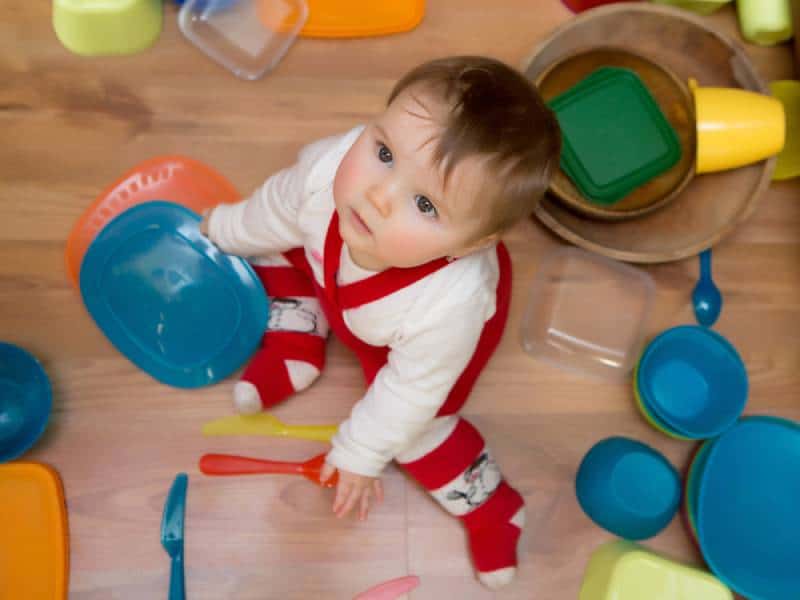
You can make your own busy board with new products or with old things lying around the house – shoelaces, old light switch, bicycle bell, mirror, and velcro strip.
Basically anything that can make a noise, be chewed or pulled on, or has flashing lights. This will keep your little one occupied for a long while.
Remember to give them time to explore each new “game” one their own first to familiarize them with the play equipment and what it can do.
Only jump in when they are ready to learn more of this particular game.
Keep it simple, don’t over-complicate it, and only add another step once they understand the previous one.
You can have waterpark fun at home too.
If you are fortunate to have a back yard, take your crawler outside, where you can make your own splash pad with a tarp and various containers filled with water.
Show your little one how to scoop water from one container and pour into another.
Let them explore the world of texture from feeling a leaf or sticks, sitting on grass, and telling him all the things around him.
You can introduce many textures like a rock that’s hard to grass that’s soft, water is wet and the towel is dry.
Food is by far the best toy to teach texture and also to improve that pincer grip all the books talk about.
Place a hand full of cereal on the tray of the high chair and watch them go nuts. They will try to pick it up, smash it – heck, even a few might go in.
An added bonus will be if you have dogs, as they’ll be waiting for the free snacks below and you won’t have to clean up!
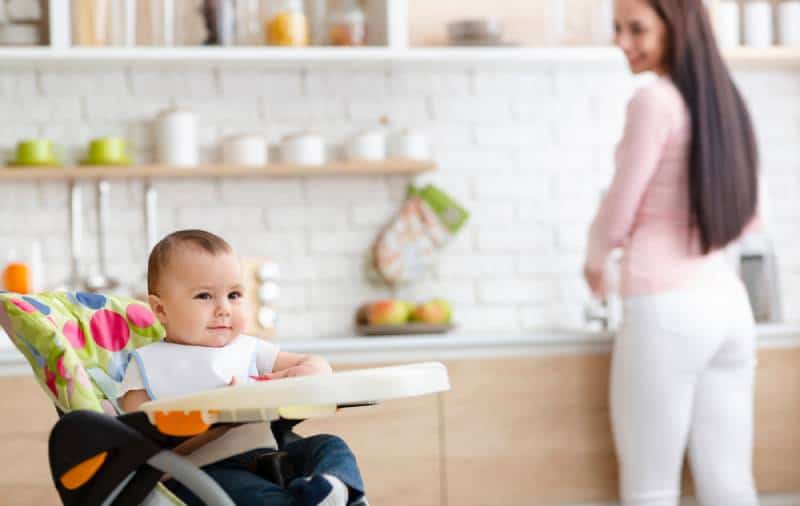
We did a very messy fun experience with our little girl with two big bowls of jelly and hid some of her toys inside (including her favorite ducky).
We placed her on the grass, the bowl in front of her and encouraged her to find all of her toys inside the big bowl of bright red cherry-flavored gooeyness.
She was sticky and sweet and a little extra pink in places, but that ducky didn’t leave her mouth for a while.
Toddlers (1-4 years)
The moment your toddler starts walking, you start running and catching and stopping and cleaning up the trail they leave behind.
What they couldn’t reach before, they now can, and you have to find new and creative ways to deter them. She gets her own set of keys, that looks just like yours, so she’ll leave yours alone.
Distraction is the name of the game.
Their minds are racing to absorb everything and those little eyes don’t miss a thing.
Even if you think you take a quick sneak peek at your phone, they will be right next to you in a flash, asking to see.
Distractions can be in the form of exercises with your energetic one. If yoga is something you do, then teach them the simple poses or stretches.
They really like downward dog! Probably because it gives them a different perspective on things.
Being still and stretching will teach them patience and how their body can move and what it feels like.
They have trouble jumping in the beginning, so let them practice jumping on the bed during diaper change times.
This will stretch those muscles and give them a great sense of balance too. If you have a baby rocker, let them explore various ways of getting in and out of it.
Let them stand on it, trying out their balance.
Just provide cushions and pillows all around for extra protection, just in case.
Again, if you see them busy learning or inspecting something, trying to understand how it works, don’t jump in immediately to explain.
Let them figure it out on their own.
You can always go assist when you see they don’t understand or are struggling. Or like in our case, our little tyke would eventually bring it to us and say “help you.”
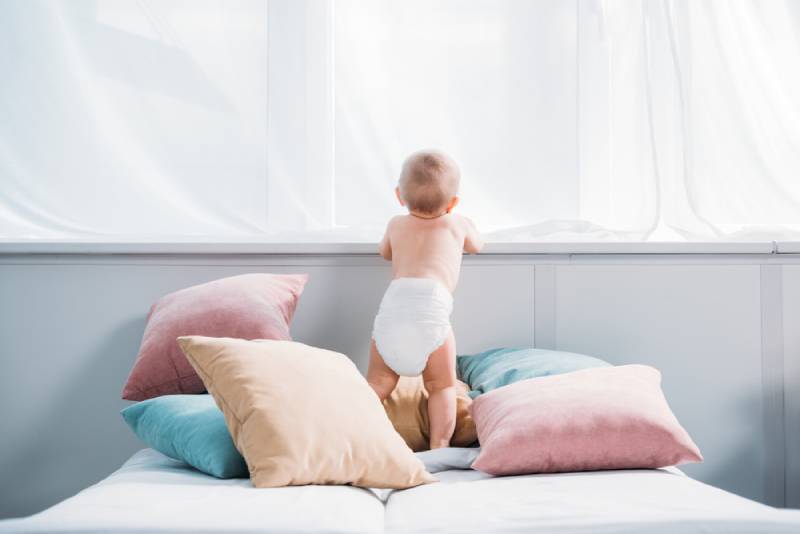
If the thought of painting makes you cringe with the messy floors or spotty carpets, do it in the bath.
There is a very easy homemade paint you can make with baby shampoo and food coloring.
Put your little one in the bath with a few colors of self-mixed paint and a brush (remember to take off clothes first!)
You can use any brush as it washes off afterwards.
They will have your bath looking like a smudgy, stripy sea of rainbows in no time.
Best part, is when you’re done, just remove the diaper, add water and you can clean the bath together and bath them the same time.
Kids love to socialize, especially with other kids. They learn a lot from older kids, but also from kids the same age.
Make a day of it and invite some little friends over for a fun day. Cousins, neighborhood friends, or even class mates.
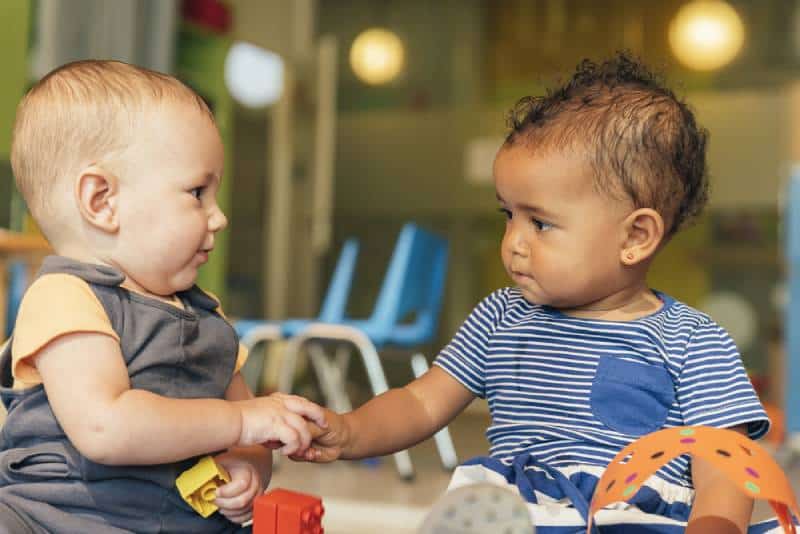
If you have a safe driveway or concrete slab, pull out the chalk and let them do their best artwork on it.
It washes off with minimal effort and will keep them entertained for quite a while.
Draw roads and signs on the driveway for the toy cars to drive (don’t worry too much about gender-appropriateness, girls love toy cars too).
Include various playhouse activities like washing dishes, preparing food, feeding pets, or even dressing the baby or changing their diaper.
In older children, this is good for early childhood development of chores and responsibilities.
You can build an entire playground for babies or even obstacle course in and around your house with the added bonus of getting the big kids to help.
Playground safety is important, so be sure to keep that in mind when building a play structure of any kind. (It might be a good idea to install retractable safety gates to prevent kids from accessing potentially unsafe areas of a home.)
Have a start and finish line, and various sections in between, and loop the course throughout your home or include the back yard.
Include obstacles like jumping over three small toys, winding their way through a sequence of numbers painted on paper plates, and balance-beam walking over a length of twine on the floor.
You could even include a chalk-drawn hopscotch or the jungle gym, bucket swings, and monkey bars if you have them.
Try to encourage numbers, colors, and sequences. Make them climb over, under, and around things, e.g. over the small chair or under the picnic table.
Have them throw a ball into a hoop or container before moving onto the next obstacle.
Create your own children’s museum experience with excavating toys in the sand box, dusting it off with a brush, and then placing the “find” in a bucket.
Stick brightly colored tape to the wall with L or R on it and let them place their left or right hand on the correct one before moving along.
Who needs rock-climbing when you could build a (safe) indoor playground for preschoolers with soft climbing structures using pillows and sofas.
Make up stories of shark infested waters or lava and that they can’t touch the floor, but have to get to one end of the living room to the next.
If you are an avid gardener, let your little one help in the garden. They’re always keen to help water the plants with a watering can or hose pipe.
Kids love any water fun, especially if they can do it themselves. Let them smell the herbs or the flowers, and even pick some for a flower arrangement you can do together later.
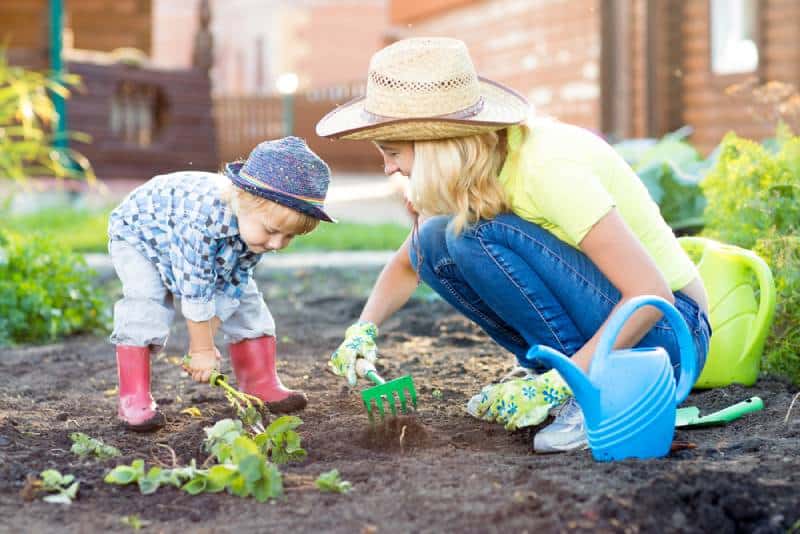
To Wrap Up
All in all, the fresh air and time spent with you are much better for your little one than any milestone book will ever be able to give.
Kids need love and support. They need to be cheered on.
They need you to do the silly dance. And they love to see your reaction to everything they do and achieve.
If our little fire cracker is anything to go by, all they really want is your attention.
Spending time with you and their family is the biggest part of any child’s development.
And trust me, you want to be part of that as much as possible.
Like this article? Please share or pin it for later. You can also stay in the loop and follow me on Facebook, Instagram or Pinterest.
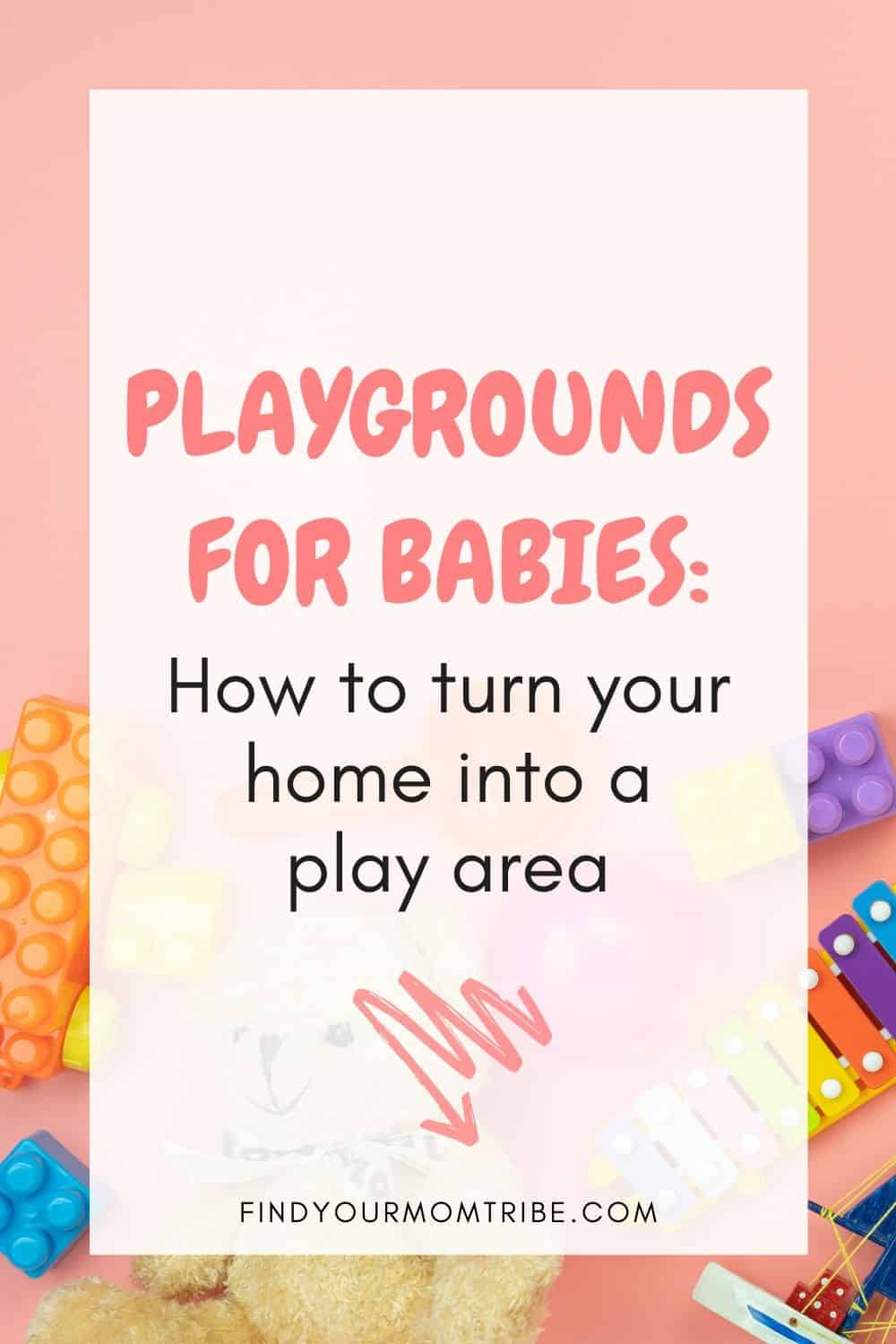
This post contains affiliate links. Please see our full disclosure for more info.

